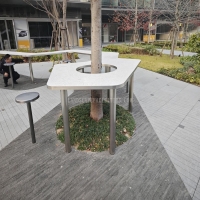Welcome to the website for landscape facilities products and knowledge.
What are the best ways to incorporate a built-in breadboard or serving tray into a landscape bar counter?
Landscape bar counters have become the centerpiece of modern open-plan living, serving as both a functional workspace and a social hub. Integrating a built-in breadboard or serving tray into this multifunctional surface not only enhances its utility but also adds a touch of sophisticated craftsmanship to your kitchen or dining area. Here are the best ways to achieve this seamless incorporation.
1. Slide-Out Tray Integration: One of the most practical methods is to install a slide-out breadboard or serving tray beneath the countertop. This design conserves space and keeps the surface clutter-free. Use sturdy, full-extension drawer slides to support the weight, and opt for materials like hardwood (such as maple or walnut) that match or complement the countertop. This allows for easy access when preparing food or serving drinks, and it tucks away neatly after use.
2. Recessed Pull-Up Board: For a more discreet look, consider a recessed pull-up breadboard that lies flush with the counter surface when not in use. This can be designed to pivot or slide out from the side of the bar counter. It’s ideal for landscape bars with overhangs, providing an additional workspace without compromising the sleek lines of the design. Ensure the mechanism is smooth and durable, with hidden handles or touch-latch openings for a minimalist aesthetic.
3. Flip-Down Serving Tray Attachment: If space is limited, a flip-down serving tray attached to the side of the bar counter can be an elegant solution. This type of tray can be hinged to fold vertically when not in use, saving space, and flipped horizontally to serve as a temporary landing spot for drinks or snacks. Use materials that are easy to clean, such as sealed wood or food-safe acrylic, and incorporate a small lip to prevent items from sliding off.
4. Integrated Cutting Board with Drainage Grooves: For those who frequently entertain, an integrated cutting board with drainage grooves can double as a serving tray for cheeses, fruits, or bar accessories. Built directly into a section of the countertop, this feature can be removable for cleaning. Choose materials that are knife-friendly and hygienic, like bamboo or end-grain wood, and pair it with a built-in groove to catch juices or spills, enhancing functionality.
5. Customizable Modular Inserts: For ultimate flexibility, design the bar counter with customizable modular inserts that can swap between a breadboard, serving tray, or even a wine rack. This involves creating cut-outs in the countertop where different inserts can be placed based on need. Use magnetic or locking mechanisms to secure the inserts, and ensure they are made from high-quality, cohesive materials to maintain a unified look.
When incorporating these elements, consider the overall design harmony. Match the wood species or finish to the existing cabinetry or countertop for a cohesive appearance. Additionally, think about practicality: ensure the breadboard or tray is easily accessible for daily use and maintainable with proper sealing to resist moisture and stains.
By blending innovation with functionality, a built-in breadboard or serving tray can transform your landscape bar counter into a versatile workstation that caters to culinary tasks and social gatherings alike. Whether you opt for a slide-out design or a flip-down attachment, this addition will elevate both the form and function of your living space.
Related search:

Recommendation
An outdoor bar counter with stainless steel and terrazzo materials in an irregular shape